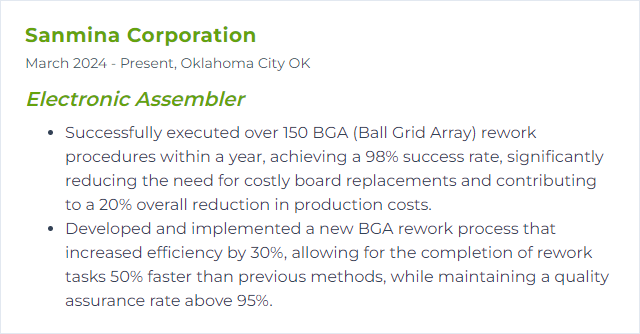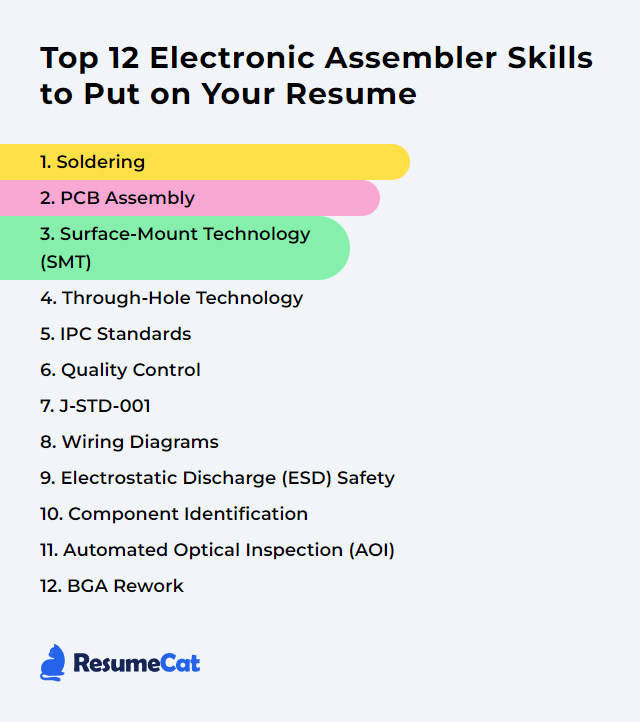Top 12 Electronic Assembler Skills to Put on Your Resume
Crafting a standout resume as an Electronic Assembler means showing a tight blend of practical technique and calm precision. Shine a light on the skills that prove you can build clean, diagnose fast, and meet spec without drama. That’s how you jump the queue in a crowded market.
Electronic Assembler Skills
- Soldering
- PCB Assembly
- Surface-Mount Technology (SMT)
- Through-Hole Technology
- IPC Standards
- Quality Control
- J-STD-001
- Wiring Diagrams
- Electrostatic Discharge (ESD) Safety
- Component Identification
- Automated Optical Inspection (AOI)
- BGA Rework
1. Soldering
Soldering joins components to pads with molten alloy, forming a durable, conductive bond that stands up to vibration, heat cycles, and time.
Why It's Important
Without sound solder joints, even perfect designs fail. Strong, clean joints keep circuits stable, safe, and serviceable.
How to Improve Soldering Skills
Use the right tools: A temperature-controlled station, quality tips, leaded or lead-free alloy matched to the job, and suitable flux.
Care for the tip: Keep it tinned and wiped; oxidation kills heat transfer and invites cold joints.
Dial in temperature: Hot enough for wetting, not so hot you scorch pads or cores. Verify with a tip thermometer if needed.
Flux like you mean it: Clean metal plus the right flux equals smooth flow and fewer reworks.
Heat the joint, not the solder: Warm the lead and pad together, then feed solder so it wicks in and wraps the fillet.
Mind the profile: Keep dwell short, watch thermal mass, and use preheat on dense boards.
Inspect every joint: Shiny, concave, well-wetted fillets. No icicles, voids, bridges, or dull, grainy surfaces.
Work safely: Vent fumes, wear eye protection, and keep the bench uncluttered.
Practice steadily and review your results under magnification. Improvement follows fast.
How to Display Soldering Skills on Your Resume
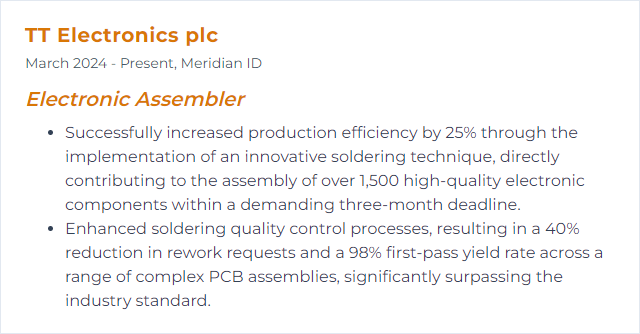
2. PCB Assembly
PCB assembly brings parts and boards together through solder paste, placement, and soldering steps to create a working circuit.
Why It's Important
This is the backbone of electronics production. Accuracy here drives reliability, throughput, and cost across the whole product.
How to Improve PCB Assembly Skills
Design for manufacturability: Clear footprints, proper pad sizes, panelization, fiducials, tooling holes, and paste apertures that print cleanly.
Quality BOM and parts: Approved vendors, lifecycle-checked components, and consistent lot traceability to cut surprise failures.
Control paste and print: Keep paste fresh, manage stencil cleanliness, and verify volume with SPI to stop defects early.
Placement precision: Calibrate feeders and machines, verify libraries, and lock down pick/place offsets.
Tuned solder profiles: Reflow and wave/selective profiles matched to alloy, board mass, and component limits.
Automated inspection: AOI and, where needed, AXI after soldering for fast defect capture.
MSD and ESD control: Respect moisture sensitivity labels and maintain ESD-safe flow.
Maintenance and calibration: Printers, ovens, and placers stay sharp with scheduled care.
Lean flow: 5S, quick changeovers, and clear visual controls to keep work moving and waste low.
Training and work guides: Current work instructions with photos, plus periodic refreshers.
How to Display PCB Assembly Skills on Your Resume
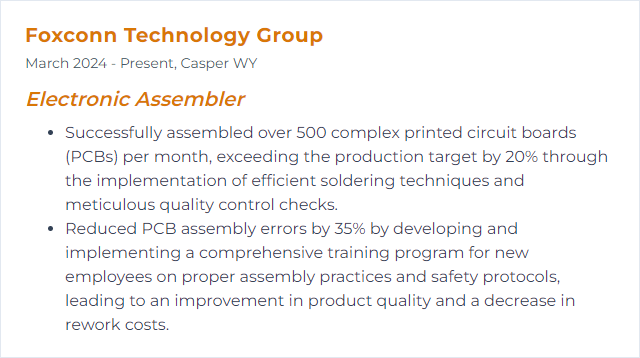
3. Surface-Mount Technology (SMT)
SMT mounts components directly onto PCB pads, enabling dense, fast, and repeatable builds with strong electrical performance.
Why It's Important
SMT powers modern electronics. Smaller parts, automated steps, consistent output—fewer errors and better cost per unit.
How to Improve Surface-Mount Technology (SMT) Skills
Layout that prints: Pad geometry, paste apertures, and components spaced for real-world printers and placers.
Stencil and paste discipline: Match thickness and aperture design to part mix; track paste age and room conditions.
Placement libraries: Accurate part dimensions, rotation, and nozzle mapping to dodge skew and tombstoning.
Reflow mastery: Profile with thermocouples on worst-case spots; watch soak, peak, TAL, and cool-down.
SPI + AOI pairing: Catch paste volume issues before placement; verify polarity, value, and solder quality after.
3D checks where needed: 3D SPI/AOI helps with co-planarity, lead standoff, and fillet shape.
Feeder care: Clean lanes, proper tension, and good reel handling prevent mispicks and line stops.
Process control: SPC on key metrics (paste height, placement accuracy, defect rate) to drive adjustments.
QMS and training: Standardized setups, documented change control, and routine skill tune-ups.
How to Display Surface-Mount Technology (SMT) Skills on Your Resume

4. Through-Hole Technology
Through-hole parts pass leads through drilled PCB holes and are soldered for a rugged mechanical and electrical joint.
Why It's Important
Great for connectors, high-power parts, and assemblies facing shock or heat. It survives where sheer strength matters.
How to Improve Through-Hole Technology Skills
Design with intent: Proper hole sizes, annular rings, thermal reliefs, and keepouts for wave or selective solder.
Prep leads: Trim, form, and clean leads to fit neatly and avoid stress on pads and plating.
Select the right method: Hand solder, wave, or selective solder based on volume, density, and risk.
Dial in flux and preheat: Enough activation and heat for full hole fill without char or bridging.
Meet fill criteria: Aim for proper barrel fill and fillet shape per acceptance class.
Inspect smartly: Visual checks, pin protrusion measurement, and electrical test for peace of mind.
Protect plastics and seals: Use pallets or masks during wave/selective to shield sensitive parts.
How to Display Through-Hole Technology Skills on Your Resume

5. IPC Standards
IPC standards define common language and workmanship criteria for electronic assemblies—everything from solder acceptability to cable builds.
Why It's Important
Shared rules reduce ambiguity, improve quality, and keep customers, auditors, and teams aligned on what “good” looks like.
How to Improve IPC Standards Skills
Earn certifications: IPC-A-610, J-STD-001, and IPC/WHMA-A-620 where relevant to your work.
Use clear work instructions: Photos, callouts, and acceptance examples matched to IPC class (2 or 3).
Audit regularly: Layered process audits and periodic workmanship checks with documented findings.
Control documents: Revision control on standards, drawings, and WIs so the floor always uses the latest.
Train and refresh: Short, frequent refreshers beat long, rare classes. Keep samples at the bench.
Close the loop: Tie defects to specific criteria and update instructions so problems don’t repeat.
How to Display IPC Standards Skills on Your Resume
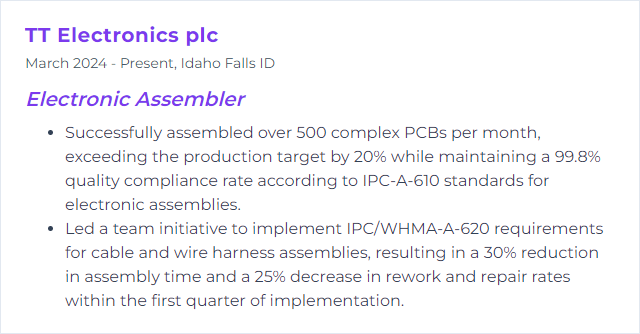
6. Quality Control
Quality Control verifies parts and assemblies meet defined specs—before they move on, and certainly before they ship.
Why It's Important
It curbs escapes, trims rework, and protects brand trust. Small catches early save big headaches later.
How to Improve Quality Control Skills
Standardize the checks: Clear criteria, checklists, and sampling plans tied to risk.
Automate where it counts: AOI, AXI, ICT, and functional test to cover what eyes can’t see.
Run a QMS: ISO 9001-style document control, CAPA, and traceability to keep improvements sticky.
Use data: SPC for key processes; dashboards that push action, not just numbers.
Calibrate and maintain: Meters, ovens, placement systems—tools drift, results suffer.
Guard the supply chain: Incoming inspection, approved vendor lists, and lot trace when issues pop up.
Root cause discipline: 5 Whys, fishbone, and verified fixes—no band-aids.
How to Display Quality Control Skills on Your Resume
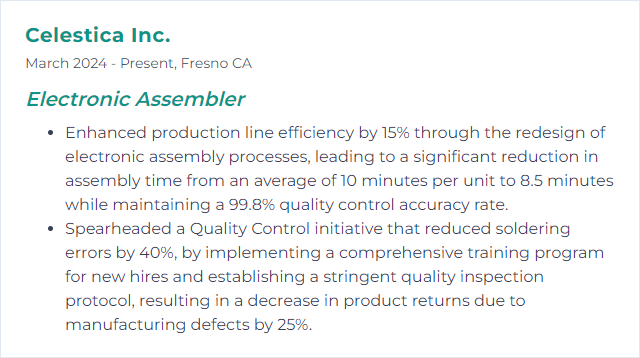
7. J-STD-001
J-STD-001 sets the bar for soldered electrical and electronic assemblies—materials, methods, and acceptance criteria for reliable builds.
Why It's Important
It anchors workmanship. Follow it, and you reduce variability, strengthen joints, and improve long-term reliability.
How to Improve J-STD-001 Skills
Get trained and certified: Hands-on courses that reinforce what “acceptable” and “defect” truly look like.
Practice with purpose: Work on mixed-technology boards and review under magnification against the standard.
Stay current: Standards evolve; update your library and bench aids when revisions land.
Use proper materials: Match flux chemistry and alloy (including common lead-free like SAC305) to the process.
Validate cleanliness: Where required, verify ionic cleanliness and residues post-solder.
Peer reviews: Short, frequent workmanship reviews sharpen judgment and consistency.
How to Display J-STD-001 Skills on Your Resume

8. Wiring Diagrams
Wiring diagrams map how signals and power travel—showing devices, connections, and terminations with standardized symbols.
Why It's Important
Assemblers need a clean blueprint. Clear diagrams prevent miswires, speed builds, and make troubleshooting sane.
How to Improve Wiring Diagrams Skills
Use consistent symbols: Stick to recognized conventions and avoid one-off shapes.
Label everything: Nets, wire gauges, colors, reference designators, connector pinouts, and ferrule notes.
Guide the eye: Left-to-right, top-to-bottom flow; minimize line crossings and ambiguity.
Call out connections: Distinguish junctions from crossovers; show shields, drains, and grounds explicitly.
Reference sheets: Provide legends, cable schedules, and terminal strip tables that match the build order.
Revision control: Date, version, and change notes so the floor never wonders what’s current.
How to Display Wiring Diagrams Skills on Your Resume
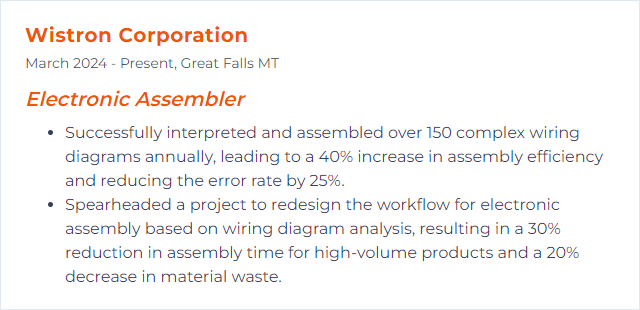
9. Electrostatic Discharge (ESD) Safety
ESD control protects sensitive components from tiny, destructive voltage spikes caused by static buildup and sudden discharge.
Why It's Important
ESD damage can be invisible at first and lethal later. Good control preserves yield today and reliability after shipment.
How to Improve Electrostatic Discharge (ESD) Safety Skills
Ground the person and the bench: Wrist straps, footwear, and grounded mats—tested daily.
Use ESD-safe tools and packaging: Shields, trays, bags, and bins that dissipate charge instead of storing it.
Manage the environment: Maintain humidity, add ionizers where insulating materials can’t be avoided.
Handle parts correctly: Touch edges, not pins; move in ESD-safe containers; label and segregate sensitive items.
Audit the program: Regular checks against a written control plan (aligned to common ESD standards) with logged results.
Train often: Short refreshers keep habits sharp and drift at bay.
How to Display Electrostatic Discharge (ESD) Safety Skills on Your Resume

10. Component Identification
Component identification means recognizing parts, packages, values, polarity, and markings so the right device lands in the right spot—every time.
Why It's Important
One wrong value or flipped polarity can sink a board. Proper ID protects function, yield, and schedules.
How to Improve Component Identification Skills
Know the codes: Read resistor/capacitor codes, diode bands, IC pin 1 markers, and package variants.
Use datasheets: Confirm footprint, orientation, ratings, and alt equivalents before substitution.
Verify with tools: LCR meters, continuity checks, and component testers catch mismarks and lookalikes.
Magnify and light: Good lighting, magnifiers, and microscopes prevent misreads on tiny print.
Watch for counterfeits: Check lot codes, label quality, and surface finish; buy from trusted sources.
Organize smartly: Clear labels, part photos on bins, and kitting that follows pick order.
How to Display Component Identification Skills on Your Resume
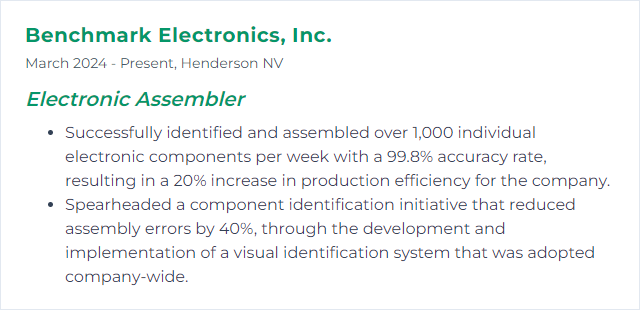
11. Automated Optical Inspection (AOI)
AOI uses cameras and software to spot defects—missing parts, skewed placements, solder issues—fast and consistently.
Why It's Important
It catches defects early, cuts rework, and provides data to stabilize upstream processes.
How to Improve Automated Optical Inspection (AOI) Skills
Get the image right: Optimize lighting angles, colors, and camera settings to boost contrast and clarity.
Build robust libraries: Accurate part shapes, polarity, and height expectations reduce false calls.
Use golden boards wisely: Program with verified-good samples and keep them updated when designs change.
Tune thresholds: Balance sensitivity to avoid both escapes and alert fatigue.
Add 3D where helpful: 3D AOI tightens checks on solder volume, coplanarity, and lead standoff.
Close the loop: Feed AOI data back to print, place, and reflow settings; fix causes, not symptoms.
Train reviewers: Skilled disposition at the review station keeps throughput high and learning continuous.
How to Display Automated Optical Inspection (AOI) Skills on Your Resume
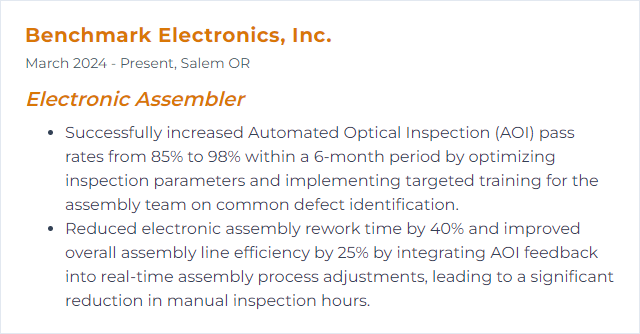
12. BGA Rework
BGA rework removes, reballs (if needed), and resolders Ball Grid Array components without harming the PCB or neighbors.
Why It's Important
It rescues high-value boards and fixes tough defects, saving cost and lead time versus full replacement.
How to Improve BGA Rework Skills
Prepare the site: Clean pads, confirm planarity, and respect moisture sensitivity (bake when required).
Profile with thermocouples: Tune preheat, soak, peak, and cool-down for the specific board and package.
Pick proper tooling: Correct nozzle, vacuum pickup, and board support to prevent warpage.
Align precisely: Optical alignment systems help center the array; nudge is better than push.
Stencil and flux: Use a matched stencil or preforms and the right tacky flux for uniform balls.
Inspect thoroughly: X-ray for shorts, opens, and voiding; follow with functional test.
Practice and document: Keep rework profiles, photos, and lessons learned to tighten future cycles.
How to Display BGA Rework Skills on Your Resume
